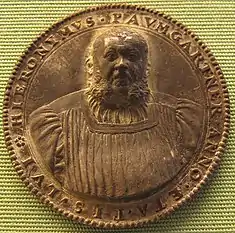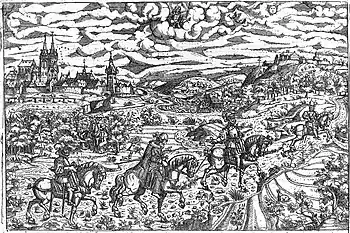
Hieronymus Baumgartner, also von Paumgartner or Baumgärtner (9 March 1498, Nuremberg - 8 December 1565, Nuremberg) was a Bürgermeister, and a major contributor to the early Reformation.
Biography

He was descended from the patrician family, "von Paumgartner auf Lonnerstadt", later known as "Paumgartner von Holnstein und Grünsberg". His father was a city council consultant, and he was tutored by Jakob Locher in Ingolstadt and Leipzig. In 1518, he became a student at the University of Wittenberg, where his fellow students included Georg Major, Joachim Camerarius and Philipp Melanchthon. He studied philosophy, mathematics, law and, under the influence of Martin Luther, Greek and Hebrew.
After graduating, he returned to Nuremberg as a follow of Luther and participated in local politics; rising rapidly. In 1525, he was elected to the city council; in 1533 he became the Bürgermeister (Mayor). He was also the city's first Kirchenpfleger (a type of financial manager for churches and schools). On a national scale, he became a "Triumvir" in 1558, which allowed him to take part in the Imperial Diet.
In 1525, he was a participant in the Nürnberger Religionsgespräch, a series of six discussions between old believers and Evangelicals, led by Christoph von Scheurl. The following year, together with Melanchthon and Lazarus Spengler, he helped establish Germany's first humanist school, the Melanchthon-Gymnasium Nürnberg. In 1536, he was involved with the Konvent in Schmalkalden, which produced the Schmalkald Articles, an ecumenical document signed by Luther in 1537. He also played a major role in introducing the Reformation to Heideck, Hilpoltstein and Allersberg.[1] In 1548, he was opposed to the Augsburg Interim, an attempted compromise by Emperor Charles V, following the Schmalkaldic War.
In 1544, as he was returning from a meeting in Speyer, he was kidnapped by the Knight, Albrecht von Rosenberg, in the forest near Treschklingen, and was held for ransom. He was held captive for over fourteen months before the ransom was paid.
He was one of the many suitors of Katharina von Bora, who would eventually marry Martin Luther. However, in 1526, he married Sybilla Dichtlin (died 1567), the daughter of Bernhard Dichtel, a pfleger (castle manager) in Starnberg; originally from Tutzing.
References
Further reading
- Victor von Kraus (1875), "Baumgartner, Hieronymus", Allgemeine Deutsche Biographie (in German), vol. 2, Leipzig: Duncker & Humblot, pp. 168–169
- Otto Puchner (1953), "Baumgartner, Hieronymus", Neue Deutsche Biographie (in German), vol. 1, Berlin: Duncker & Humblot, pp. 664–665; (full text online)
- Friedrich Wilhelm Bautz (1975). "Baumgartner, Hieronymus". In Bautz, Friedrich Wilhelm (ed.). Biographisch-Bibliographisches Kirchenlexikon (BBKL) (in German). Vol. 1. Hamm: Bautz. col. 425. ISBN 3-88309-013-1.
- Michael Diefenbacher (2000), Michael Diefenbacher, Rudolf Endres (ed.), Paumgartner von Holnstein und Grünsberg, Patrizierfamilie, Nuremberg City Lexicon (Stadtlexikon Nürnberg) (in German) (2nd, revised ed.), Nuremberg: W. Tümmels Verlag, ISBN 3-921590-69-8
- Gustav Bossert: "Die Gefangenschaft des Hieronymus Baumgartner und die Nürnberger vor Haltenbergstetten". In: Württembergische Vierteljahrshefte für Landesgeschichte, Vol. 11 (1888), pps.207–217 (online).
External links
![]() Media related to Hieronymus Baumgartner at Wikimedia Commons
Media related to Hieronymus Baumgartner at Wikimedia Commons